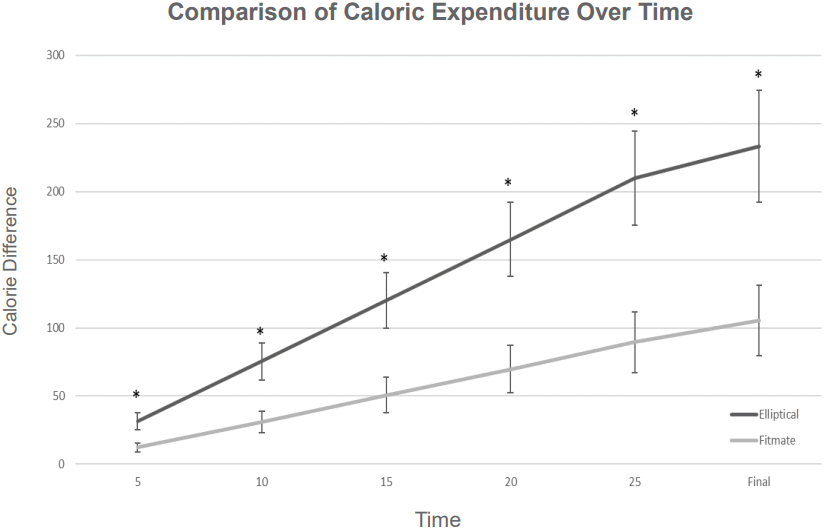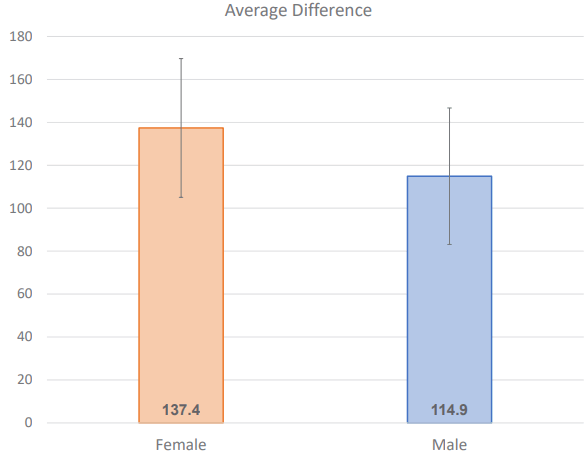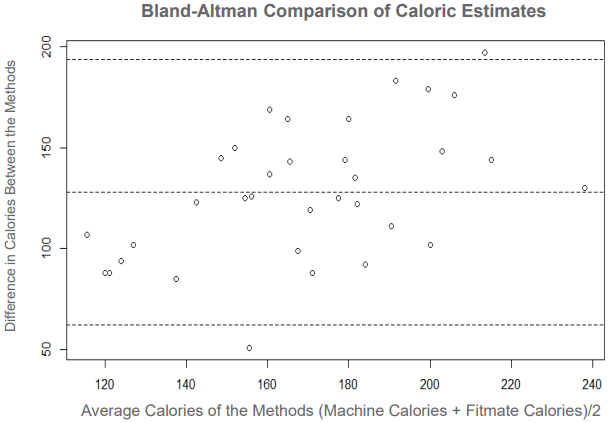INTRODUCTION
Although it is generally accepted that the caloric expenditure estimates obtained from exercise equipment are not accurate, there is little research regarding the magnitude of the difference in the estimates compared to indirect calorimetry, how the difference changes over time during steady state exercise, and if the differences are greater for males or females. It would benefit both the exercise science professional and the layperson to have a general idea of how much one could expect these numbers to differ as there are many people trying to balance energy expenditure and caloric intake. There are established equations for estimating caloric expenditure for both overground and treadmill walking and running [1], but the information available for elliptical machines is limited. As the elliptical trainer is a popular, low-impact option [2] for cardiovascular exercise, it is important to have a better understanding of the discrepancy between caloric expenditure as measured by indirect calorimetry versus the estimate generated by the equipment’s internal programmed algorithms.
The elliptical has been identified as a positive method of exercise for multiple reasons. The elliptical has a lower Rating of Perceived Exertion (RPE) than is indicated by physiological response [3] which makes the exercise “feel” easier. It also has been found to provide the same cardiovascular training stimulus as the treadmill while resulting in higher peak oxygen consumption, average heart rate, and respiratory exchange ratio [4]. The elliptical also reduces weight-bearing compared to both over ground and treadmill walking and running [2] making it a lower impact exercise than walking and running. This combination of factors makes elliptical machines a viable option for the population in general and specifically for those who may need to reduce joint impact.
However, energy expenditure has been found to be overestimated by some elliptical machines [5], with resistance, but not stride rate affecting the difference. Lower resistances were found to overestimate caloric expenditure less than higher resistances. This is not a problem unique to the elliptical as rowers [6] and other equipment [7] have also been shown to deviate from the numbers obtained from more precise methods of assessing caloric expenditure. It is generally accepted that these numbers are going to be inaccurate [8-10], but there is little information about how much these estimates may be in error. These estimates are also impacted by the amount of information entered by the participant. Entering information such as age and weight may make the calculations more accurate, however, many exercisers choose to utilize the “Quick Start” function that does not require entering this information. When participant information is not entered, the Precor brand of elliptical machines uses default user characteristics of 150 lbs, 35 year old, and male to calculate caloric expenditure for most models, with models having a P80 console using a weight of 170 lbs [11]. These values likely only represent a small percentage of users. It is unlikely that the typical user will research this information, thus it is incumbent on exercise science professionals to do so in order to educate the general public.
As this information is of value to both the layperson and the exercise professional, the purpose of this study was to examine the difference in caloric expenditure as measured through indirect calorimetry and estimated by an elliptical machine. The overall difference in caloric expenditure was the primary variable of interest. In addition, the progression of the difference over time and whether the difference was significantly different between males and females was examined. It was hypothesized that there would be a significant difference over time, the difference would get larger as duration increased, and there would be a larger difference for females than males.
One aspect of this study was to make conditions as uniform as possible. A moderate intensity was chosen as something that would be accessible by most individuals, would represent a typical exercise session on an elliptical, and would not limit the subject pool. Heart rate and ratings of perceived exertion (RPE) were selected to monitor intensity. Heart rate was included as an objective standard. A 1-10 modified RPE scale was used for subjective intensity, which was deemed important since the elliptical has shown lower RPE ratings than physiological ratings [3]. The “Quick Start” mode was also selected to ensure the same equation would be used for each participant. Although entering information could have led to less variability, the consistency of the equation was deemed more important for this study. Additionally, many individuals use the quick start function rather than entering the data necessary to update the equation. Using quick start rather than the more individualized equation also serves to provide a more real world example. To keep conditions as uniform as possible, resistance, ramp height, and intensity were also controlled. This allowed stride rate to vary for each participant. Although keeping stride rate consistent may have been beneficial, Mier and associates [5] found that stride rate did not impact the difference in overestimation of energy expenditure by elliptical equipment using arm and leg movements. Thus allowing stride rate to vary while controlling for resistance and intensity was determined to be the most logical way to achieve the study’s purpose. Steady state exercise was chosen to avoid large variations in intensity and increase standardization between participants. The exercise session consisted of a 5 min warm-up below the moderate intensity heart rate zone, 20 min of moderate intensity exercise, and a 5 min cool-down. Caloric expenditure was then measured via indirect calorimetry using a FitMate Pro® (COSMED USA) and compared to the caloric expenditure estimated by the elliptical (Precor EFX 883, Precor, Woodinville, WA USA).
METHODS
Subjects
There were 34 subjects in this study (14 males and 20 females, Table 1) recruited on a college campus in the southern United States. Although adults aged 18 to 64 were recruited, as can be expected when conducting research on a college campus, the subjects did tend to be younger adults. Subjects completed a health history questionnaire prior to participation to ensure they could safely participate in moderate intensity exercise. Any adult who could safely complete moderate intensity exercise based on the American College of Sports Medicine guidelines without requiring physician clearance [1] was eligible for participation. There were no weight restrictions. Individuals with risk factors below the level requiring physician clearance to participate in moderate intensity exercise were eligible to participate. All participants provided written informed consent, and the study was approved by the Institutional Review Board at Sam Houston State University, protocol number 14164.
Procedures
Height and weight. Height (in meters) and weight (in kilograms) were measured on a standard balance scale with stadiometer (Health-O-Meter Model 400KL, Boca Raton, FL USA). Participants wore lightweight attire and removed their shoes for height and weight measurements.
Exercise testing. Moderate intensity exercise was selected to avoid limiting the participant pool due to potential inability to complete the exercise session and to keep the exercise intensity at a safe level. Exercise intensity was monitored via heart rate (using the chest strap provided with the FitMate Pro®, COSMED USA) and ratings of perceived exertion (RPE). For heart rate, the estimated maximum heart rate was calculated using the formula developed by Gellish et al. [12]: Maximum heart rate = 207 – (0.7 × age). This formula is reported to be appropriate for adults with a broad range of fitness [12]. Moderate intensity was then set at 64-76% of the predicted heart rate maximum. Heart rate was monitored continuously throughout the exercise session (warm-up, moderate intensity, and cool-down). The Borg CR10 Ratings of Perceived Exertion scale [13] was used for RPE. The scale was displayed on the display panel of the elliptical as well as on a wall for quick access. Participants were instructed on usage of the scale and allowed to ask questions as needed until the scale was understood. Ratings (RPE) were collected during the last 30 seconds of each 5-minute block of the exercise session (warm-up, 0 to 5 min of moderate exercise, 5 to 10 min of moderate exercise, 10 to 15 min of moderate exercise, 15 to 20 min of moderate exercise, and cool-down).
The exercise session consisted of 30 min on an elliptical trainer. The “quick start” function was used to ensure the default caloric expenditure calculation was used. Although the addition of demographic information (age, etc.) might increase the accuracy of the caloric estimates, the amount of information that can be entered varies from machine to machine and can be cumbersome so many people choose not to enter any additional information and simply begin exercising. A warm-up of 5 min was used to prepare the participant for moderate exercise. Resistance was set at level 1, and the ramp level was set at 5. During the warm-up, the participant was instructed to keep the heart rate below moderate intensity. Heart rate was also monitored, and participants were alerted to reduce intensity if moderate intensity was reached. After the warm-up, the participant immediately began 20 min of moderate intensity exercise. During the moderate exercise portion, the resistance was set at 5, and the ramp level was set at 10. Immediately upon completing the 20 min of moderate intensity exercise, a 5 min cool-down period began. The resistance and ramp settings were the same as the warm-up period (1 and 5 respectively). Participants were asked to drink as normal prior to the exercise session, but to refrain from substances containing caffeine. Participants were also asked not to eat a large meal within 2 to 3 hours of their scheduled testing time. It was also requested that lightweight exercise clothing be worn.
Statistical analysis
This study was a descriptive analysis of a single-time point exercise session. The comparison of overall caloric expenditure as reported by the elliptical machine (Mac) and the FitMate Pro (Fit) was analyzed using paired t-test. A Bland-Altman analysis was also conducted to compare the overall caloric expenditure. The comparison of overall difference in caloric expenditure between methods for males versus females was analyzed using an independent samples t-test. A repeated measures ANOVA was used to examine the difference between methods at 5 min. intervals during the 30 min. exercise session. Significance was set at p < .05 for all tests. This investigation compared the two measurement methods, thus sample size for adequate power to detect these differences was the focus. Power was found to be greater than 0.99 for the comparison of methods and the analysis of differences over time. A comparison of gender was not the focus of this investigation, and thus was not a focus in terms of recruiting subjects for adequate power in this comparison. However, as gender may be important, an exploratory analysis of this aspect was conducted. Power was only 0.50 for the comparisons of males versus females. A sample size of approximately 34 participants per gender (compared to the actual sample size of 20 females and 14 males) would have been needed to reach a power of 0.80. This information will be useful for future studies. Analysis was completed using SAS 9.4 (SAS Institute Inc., Cary, NC), SAS Power and Sample Size 13.1 (SAS Institute Inc., Cary, NC), RStudio Version 1.1.419 (RStudio, Inc., Boston, MA) and Excel 2016 (Microsoft Corporation, Redwood, WA).
RESULTS
There was a difference overall between the two caloric expenditure methods for all participants (t33 = 22.27, p < .001). The difference also increased significantly over time from 19.04 ± 5.65 C at 5 min to 120.42 ± 26.59 C at 25 min (F4,116 = 613.87, p < .001, Figure 1). However, there was no difference between males and females for the discrepancy between the two caloric expenditure methods (t32 = 2.01, p = 0.05; M: 114.9 ± 31.77 C, F: 137.40 ± 32.31 C; Figure 2). The Bland-Altman plot does seem to indicate some disagreement in the measurement methods (Figure 3). The mean difference between methods was 128.09 ± SD, with Mac consistently measuring higher than the Fit (p < .001). The regression equation for predicting Fit from Mac was Fit = 0.36 (Mac), with the slope being significant (p < .001). However, the intercept (20.21) was not significant (p = .35).
DISCUSSION
Although the inaccuracy of calorie counts from machines is somewhat well-known, knowing specifics about how inaccurate the information is can be helpful. The Bland-Altman plot (Figure 3) supports that there is a fairly large discrepancy between measurement methods. Based on this study, one could estimate the machines overestimate caloric expenditure by about 130 calories during a steady-state bout of moderate exercise lasting 30 min, including warm-up and cool-down. Interestingly the overestimation was not significantly different for males (114.9 ± 31.77 C) versus females (137.4 ± 32.31 C), though the difference does tend to be greater for females. The discrepancy also increases by about 25 C for each 5 min block of steady-state moderate exercise for females compared to males. The results of this study support previous studies that found cardiovascular equipment overestimated caloric expenditure [5,6]. The finding that there was not a statistical difference between the discrepancy for caloric expenditure based on gender is similar to the findings by Erdogan and associates [6], but differed from Moyna et al. [7] who found a significant difference based on gender. It is likely that the sample size was not large enough to detect significant differences based on gender. Specifically, Erdogan et al. [6] had a relatively similar sample size and split between males and females. It is possible that both this study and the Erdogan study had insufficient sample size to achieve adequate power for the comparison of gender. Future research should specifically address this issue and recruit participants to achieve adequate power for the gender comparison.
Differences are to be expected given the generic information used to calculate caloric expenditure, and individuals should be encouraged to enter as much information as possible if they intend to use the caloric expenditure estimates from cardiovascular equipment as this may increase the accuracy of the calculations. Future research should examine what factors are most important for accuracy. Individuals should also be encouraged to use other tracking methods that may provide more accurate information, such as heart rate monitors. Possessing information about how inaccurate cardiovascular equipment is in estimating caloric expenditure is a helpful piece of information for the general population of elliptical users who are wanting to balance caloric expenditure with caloric intake.
CONCLUSIONS
There are a few key takeaways from this study: the elliptical machine significantly overestimated caloric expenditure compared to indirect calorimetry; the overestimation increased with exercise duration; and the amount of overestimation by the elliptical was not significantly different between males and females. Exercise professionals should keep this in mind when working with clients interested in weight management. If it is important to have accurate estimates of caloric expenditure, more accurate methods should be used to avoid large caloric deficits or surpluses. If more accurate methods are not available, individuals should enter as much data as possible when using cardiovascular exercise equipment as this should serve to decrease the overestimation of caloric expenditure.













